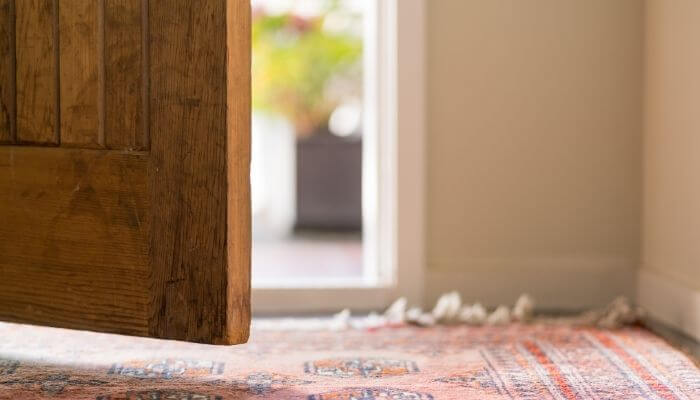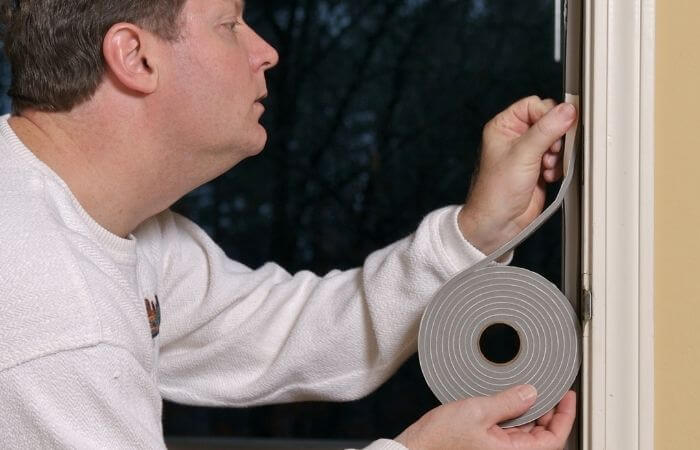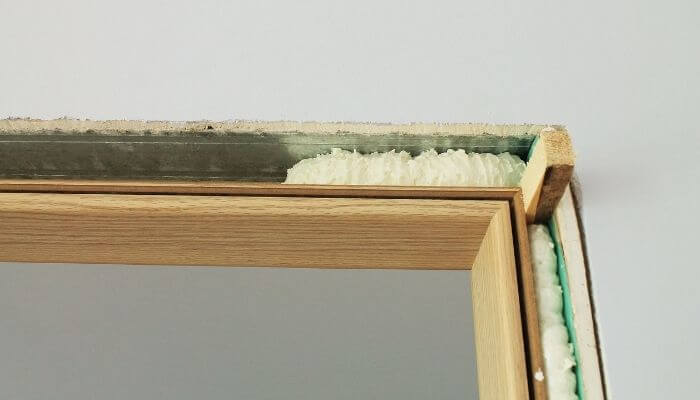Sometimes the most effective way of keeping noise out of a room is to soundproof the door.
Below we talk you through some of the most effective door soundproofing methods such as fitting bronze weatherstripping and acoustic thresholds to some quick low budget methods such as using a draft excluder or door drapes.
| Method | Effectiveness | Cost |
|---|---|---|
| Sound Lock Soundproof Door | 10/10 | $3,000+ |
| Bronze Spring Weatherstripping | 10/10 | less than $35 |
| Acoustic Thresholds | 9/10 | less than $50 |
| Automatic Door Bottoms | 9/10 | up to $110 |
| Hardwood Door | 8/10 | Depends on the door |
| Draft Excluder | 7/10 | less than $20 |
| Standard Weather Stripping | 9/10 | less than $15 |
| Add Mass | 7/10 | Less than $30 |
| Seal The Doorframe | 7/10 | Less than $15 |
| Door Sweep | 8/10 | Less than $10 |
| Acoustic Door Curtains | 8/10 | Depends on the curtains |
| Blankets | 6/10 | Free (if you have spare blankets) |
Highly Effective Ways To Soundproof A Door:
There are many ways to soundproof a door, below are 5 of the most effective methods that a professional would use.
If you’re looking for quick and cheap ways to soundproof a door then click here to skip ahead.
1. Bronze Spring Weatherstripping
Bronze spring weather stripping will completely seal up gaps around a door.
It works in the same way that foam weatherstripping does however it is more effective and it will last for up to 35 years.
To install bronze spring weatherstripping you will need:
- Nails
- Hammer
- Awl
- Tin Strips
- Bronze spring weatherstripping
- Marker pen
- Measuring Tape
1. Measure & Cut
First measure the inside of your door frame, you will need the width of the door frame and the length of the door jamb (the vertical part).
Then unroll the weatherstripping and mark up the lengths so you know where you need to cut it.
Use your tin snips to carefully cut it to the required length.
Most metal weatherstripping will come with nail holes, however if yours doesn’t then use the awl to mark nail holes every 3cm or so.
2. Hang The First Strip
The first strip should be hung along the door jamb (where the hinges are).
Line it up so that it is as close as it can be to touching the door threshold without actually touching it.
Use the tin snips to cut away any metal which may get in the way of hte hinges.
3. Secure With Nails
Important note: Take care when nailing to ensure that the nail head is flush with the strip, do not drive it into the metal as this will damage it and may compromise the effectiveness of the weatherstripping.
Secure the strip with one nail at the top and one at the bottom, check that it is straight and properly aligned.
Once you are happy with the alignment then completely nail it down.
4. Fit The Remaining Strips
Repeat steps two and three for the other two strips.
You should fit the top strip last, take care to ensure that it joins up in the corners without impeding the movement of the door.
2. Acoustic Thresholds
An acoustic door threshold works in a similar way to a door sweep. It creates a (more or less) airtight barrier between the door and the floor preventing airborne sound from getting through.
A standard door threshold is the piece of metal which sits underneath your door and covers the join between your flooring.
Acoustic door thresholds kits differ to standard thresholds because they have a raised lip which runs down their middle, this is usually made of rubber.
They work by creating a seal with the door when the door is closed.
Combining one with a door sweep will mean that the bottom of your door is double sealed and therefore pretty much impenetrable to all sound!
How To Install An Acoustic Threshold:
The installation will require a screwdriver, a drill (not always necessary), screws, a saw and a claw hammer.
- Unscrew the screws on your original threshold and pull up the threshold. You may need to slide the clawhammer underneath the threshold to help lever it off.
- Measure the space and check that your new acoustic threshold fits, if not cut it to size.
- Place your new threshold down and use a pen to mark where the screws will go – if you are lucky the holes may line up with your previous holes.
- Before you secure it check the door can close over it and that the rubber seal is positioned correctly, if not make adjustments.
- Drill small guide holes for the screws to go into.
- Screw the threshold down, ensuring that all screws are tightened up completely so that the head is not protruding at all (otherwise you will be forever ripping your socks on it!) and there is no gap beneath the threshold and the floor.
Be aware that acoustic thresholds do have a raised lip so they are not suitable for elderly people, partially sighted people or anyone who may be likely to trip on it.
3. Automatic Door Bottoms
Automatic door bottoms are a step up from acoustic thresholds.
If you are concerned about someone tripping over the raised lip of an acoustic threshold then an automatic door bottom is a suitable alternative.
These can be embedded inside the bottom of your door so that they are invisible. They can also be screwed into the inside of your door.
When the door is closed a small plunger embedded in the door bottom is depressed, this releases the rubber seal so that it drops to the floor and closes the gap.
When the door is opened the plunger pops back out and the rubber seal immediately lifts back up allowing the door to close freely without any drag.
When installing an automatic door bottom it is important that you ensure that the rubber seal fits flush with the bottom of your door and that the plunger is positioned correctly so that the mechanism fires correctly when the door is opened or closed.
How To Install An Automatic Door Bottom Kit:
Depending on which automatic door bottom you get installation techniques will vary slightly, generally most screw on door seals will follow the steps below:
- Measure the distance between the doorjambs (this is the part of the doorframe that stops your door when it is closed).
- Cut the door seal using a saw so that it is 2mm less than the length between your doorstops.
- Close your door and place the seal level with the bottom of the door and tightly between the doorstops to ensure that you get the positioning correct.
- Screw the automatic door seal into position.
- Most automatic door bottoms have an adjusting screw on one end (normally the end closest to the hinges), practice opening and closing your door if the seal doesn’t drop down when the door is closed tighten the adjusting screw until it works as required.
If you are installing a door seal which is designed to be embedded in the bottom of the door then we recommend getting a carpenter to help as it can be a tricky job.
4. Fit A New Door
Most internal doors are hollow, light and flimsy, providing no real sound resistance.
A dense hardwood door will block much more sound.
This is because it is thick and does not have a cavity inside it for sound to reverberate around in. This will help to dampen any sound passing through your door.

When buying a new door you should look for something which is made of solid timber – avoid hollow core doors at all costs!
It is a good idea to get a joiner to install it so that it fits the frame perfectly.
Ill-fitting doors will allow sound to get in so it is vital that your door fits well so that it is soundproofed effectively.
If you really want to achieve extremely high levels of soundproofing then you could fit a Sound Lock Soundproof Door which boasts a very impressive STC rating of 56, far more than even the densest hardwood doors could achieve!
Quick, Budget Friendly Ways To Soundproof A Door:
If you don’t have much time or money to spare and you need a solution to your door noise problem then here are some easy ways to reduce the amount of sound coming through your door without having to spend much money:
1. Use A Draft Excluder
A lot of noise can get through the gap underneath your door, a simple way to deal with this is to buy a draft excluder.
Draft excuders are designed to stop air from passing under your door (hence their name), this means they are perfect for preventing the transfer of airborne noise.
A good draft excluder can be picked up for less than $20
2. Use Weather Stripping
Sealing gaps between your door and the frame is one of the most impactful door soundproofing methods.
The most efficient way of doing this is to apply door weather stripping around the edge of your door where the door sits when closed.
Weatherstripping is used for preventing draughts. If air can get through then airborne sound can get in too, so it is weatherstripping is very useful for soundproofing.

The primary reason why many doors leak sound is that they don’t fit their frames well, this allows airborne sound to flow freely into your room.
Using weatherstripping is a simple and highly effective method of completely sealing up the gap around your door.
Make sure you buy high quality stripping as cheap options will quickly degrade and fall to bits, rendering them useless.
Installing weatherstripping is very easy, particularly if you buy stripping that is self-adhesive. All you need to do is peel off the back and press it tightly into place.
When you have finished close your door and leave it closed for a few minutes to seal the stripping down.
If your weatherstripping is not self-adhesive be sure to glue it in with a high-quality adhesive bond that resists vibrations.
Weatherstripping has it’s limitations though – it can’t seal the gap at the bottom of your door, and this area can be a big problem for many doors.
Weatherstripping combined with a door sweep make for a serious door soundproofing solution.
It’s not uncommon for a door to have 10mm of space beneath it, which obviously will let a lot of sound in….to fix this you need to get a door sweep…
3. Add Mass
One of the most basic facts of soundproofing is that mass blocks sound.
The problem with many interior doors is that they are completely lacking in any substantial mass. They are usually hollow with their structure supported by an internal cardboard lattice.
They are not thick, they are not heavy and because of the hollow space inside them and the thin panels they are made from they can even sometimes amplify vibrations a bit like a drum. Clearly, they make for an inadequate barrier.

Adding mass to your door will have a significant impact on how much sound it lets through. Particularly if the problem sound is impact/sound vibrations rather than airborne sounds.
Note: Some people suggest attaching foam to your door to help soundproof it.
This won’t work! All this will do is reduce echo within the room, it won’t stop sound from passing through the door.
There are a number of ways to increase the density of your door.
You could use wooden MDF, cut it to size and fix it on the side of the door where the sound is coming from or you could use a dense vinyl which sticks to your door and minimizes vibrations.
Vinyl material is the sort of things that is commonly used in recording studios. If aesthetics are important to you then vinyl is a good option. However dense vinyl is typically more expensive than MDF.
MDF is a far cheaper option which, with a bit of sanding and painting, can be made to look aesthetically pleasing too…it just takes more effort!
How To Add Mass To Your Door With MDF:
To add mass to your door using MDF you will need; Medium Density Fibreboard big enough to cover your entire door, green glue (or an alternative), wood screws, a drill and a screwdriver.
- Get a piece of smooth MDF which is big enough to cover your board, ideally at least 0.5 inch thick.
- Measure out your door and cut the MDF to size, remember to cut holes for handles and locks – alternatively you can remove the handle and fit a dummy handle to the MDF with a ball and catch latch, this will minimize noise weak points in your door.
- Cover the back of the MDF with green glue. Use it liberally; apply 1-2 full tubes.
- Drill guides holes through the MDF and into the door then fit the MDF tightly into the door with a screw in each corner and three across the middle of the door.
Once you have added mass to your door it is then important to completely seal it up.
4. Seal The Frame
The gaps between your wall and door frame can often allow sound to leak through.

Sealing a door frame requires a steady hand and some good quality acoustic sealant such as green glue. If you have both of these then follow the steps below.
How To Seal A Door Frame:
- Place masking tape around the frame. The masking tape should be stuck to your wall flush with the frame.
- Fit your sealant of choice into a sealant gun.
- Apply the sealant into the gaps around the frame.
- Smooth out the sealant using your finger dipped in some warm water – simply dip your finger in some warm water and run it over the sealant to get a smooth, clean and well-sealed finish.
- Remove the masking tape and leave it to dry.
Sealing up your door frame will definitely help make your room quieter if you are having problems with airborne noise.
5. Install A Door Sweep
Adding a dense rubber sweep to the bottom of your door will do wonders when it comes to soundproofing against airborne noise.
- Robust adhesion: door draft stopper, filling gaps up to 1 inch, equipped with exceptionally strong adhesive that remains intact over time, ensuring a secure bond for enduring door protection; Kindly...
- Noise reduction: the door bottom seal designed by special structural, keep your room quiet, clean, suitable temperature
- Save money and energy: the most efficient solution to prevent the heat and cold from escaping during winter and summer, reduce electric cost
Even if you only have an imperceptible gap between your door and the floor this can be a huge sound leak.
A rubber door sweep does exactly what you would expect; it sweeps the floor as the door is closed creating a barrier between the door and the floor making it much harder for sound to get through. Typically a good one can be bought for a price around $30 or less.
Installing a door sweep is very simple and can usually be done by even the most inexperienced of D.I.Y practitioners.
Installation methods will vary slightly depending on the door sweep you choose to install but the steps will usually be more or less as follows:
How To Install A Door Sweep:
- Measure the width of your door and if necessary cut the door sweep to fit.
- Mark holes on your door where the screws will go.
- Drill small pilot holes to guide the screws in – make sure that the holes are not too big or the screws will not be as secure and the sweep will not be tightly secured meaning it will be less effective.
- Loosely attach the sweep and check that it fits well and that your door can open and close and hold a good seal when closed.
- Tighten the screws and you’re done!
Be aware that some people may not like floor sweeps on their door because they can damage the carpet and they make a swishing noise every time you open or close the door.
If this is the case for you then try using an acoustic threshold instead – ideally, you should combine the two for the best results.
Also Read:
6. Acoustic Curtains
Hanging curtains over a door may sound like a strange idea but many of us have one hanging over our front doors which we draw closed at night to keep the heat in.
Using soundproof door curtains works in much the same way as it does for insulating a door.

The key is to make sure that the fabric you use is thick and multilayered, the more layers the better as this helps muffle sound waves, you could even get a consider getting a specially made acoustic curtain.
Curtains work by dampening and absorbing sound going both in and out of your window. While they won’t ‘soundproof’ your window they may make a sufficient barrier to take the edge of an irritating noise to a level that will allow you to sleep.
How To Install An Acoustic Curtain Over Your Door:
Soundproof curtains are dense, they have to be to have any noticeable dampening effect.
This means that they are much heavier than normal curtains so you will need to get an extra-strong steel rail which must be properly installed otherwise there is a good chance it may fall off the wall! If you are not confident ask a professional for help – many suppliers will offer to fit for a small fee.
If you feel confident then follow these steps to install your door-curtain:
- Measure the width and height of the door, the rod should be around 7 inch longer than the width of the door.
- Use a stud detector to find where the studs are in your wall, mark the studs using a pencil.
- Measure how long your curtain is so you can work out what height the rail needs to be to cover the entire door. For the best soundproofing results, you should hang the curtain at a height that gives it about an inch or two of fabric draped on the floor.
- Hold your rail bracket onto the wall and mark where the screws will need to go (make sure you are over a stud), also make sure that both brackets are at exactly the same height on either side of the door.
- Make small guide holes using a nail.
- Screw the brackets in.
- Attach your curtain to the rail.
- Lift the rail onto the brackets (you may need assistance with this).
- Test the strength of your rail by giving the curtain a few gentle pulls to ensure that it won’t fall off if the door catches the curtain.
7. Use Blankets
If you are staying over in a hotel or a rented room and you are being disturbed by noise coming through your door then you need a quick and immediate solution to quieten your noise problem, there is no time for a big D.I.Y project!
Using blankets is an easy solution that takes no time and requires minimal materials.

If you have ever done a fire safety training course you will be familiar with the idea of rolling up blankets and pushing them into the bottom of the door to prevent smoke from filling the room.
Blankets work for blocking air which means they can also be used to help block sound.
Simply roll the blankets up and push them firmly into the gaps. Double up the blankets to dampen as much sound as possible.
In this sort of situation, it could also be a good idea to download and use a white noise app to help drown out the background noise.
This combined with your blankets will hopefully allow you to get a good nights sleep even if you are staying somewhere relatively noisy.
We hope this article helped you work out the best way how to soundproof your door and that your new-found tranquillity helps you sleep much better!
Got a bi-fold door? Read our article on How to Soundproof a Bi-fold Door.Got a bi-fold door? Read our article on How to Soundproof a Bi-fold Door.
As an Amazon Associate I may earn a small fee from qualifying purchases at no extra cost to you. This helps us run the site, so thanks for your support!




